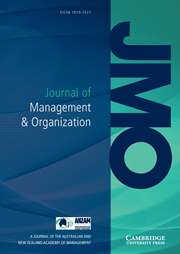Article contents
International alliance structure and effectiveness: evidence from law firms
Published online by Cambridge University Press: 05 April 2023
Abstract
International alliances are important strategic vehicles to build geographic scope and enter foreign markets, especially for firms lacking the resources or facing limitations to direct foreign expansion. Addressing recent calls to study alliance structure, we investigate the design parameters of nonequity international alliances and their performance implications. Building on the resource-based view of the firm, we theorize the effect of three key structural dimensions – formalization, interface, and specialization – on firm effectiveness. Our empirical work focusses on the legal service industry where international interfirm alliances are common, and resources like expert workers and knowledge are essential. We study 121 French, German, Italian, and Spanish law firms; and our data include the structural features of the alliances to which they belong, as well as various measures of firm effectiveness. Our analyses via structural equation modelling point toward the importance of informality and strong interface for effectiveness in these contexts. This study contributes to a finer understanding of international alliances by directly addressing the structural variation among nonequity international alliances, and analyzes their implications for firms. We thus respond to calls to investigate structural dimensions of alliances, operationalizing relevant dimensions of alliance organizational structure. Second, we add to understanding of the performance effects of international alliances, showing the benefits of individual structural parameters for firm effectiveness. Finally, we extend research on the use of international alliances as a strategic vehicle to enter foreign markets, capturing essential aspects of the internal arrangements of these interorganizational collaborative relationships, and thus adding to understanding of this strategic entry mode.
Information
- Type
- Research Article
- Information
- Copyright
- © The Author(s), 2023. Published by Cambridge University Press in association with the Australian and New Zealand Academy of Management
References
- 2
- Cited by

